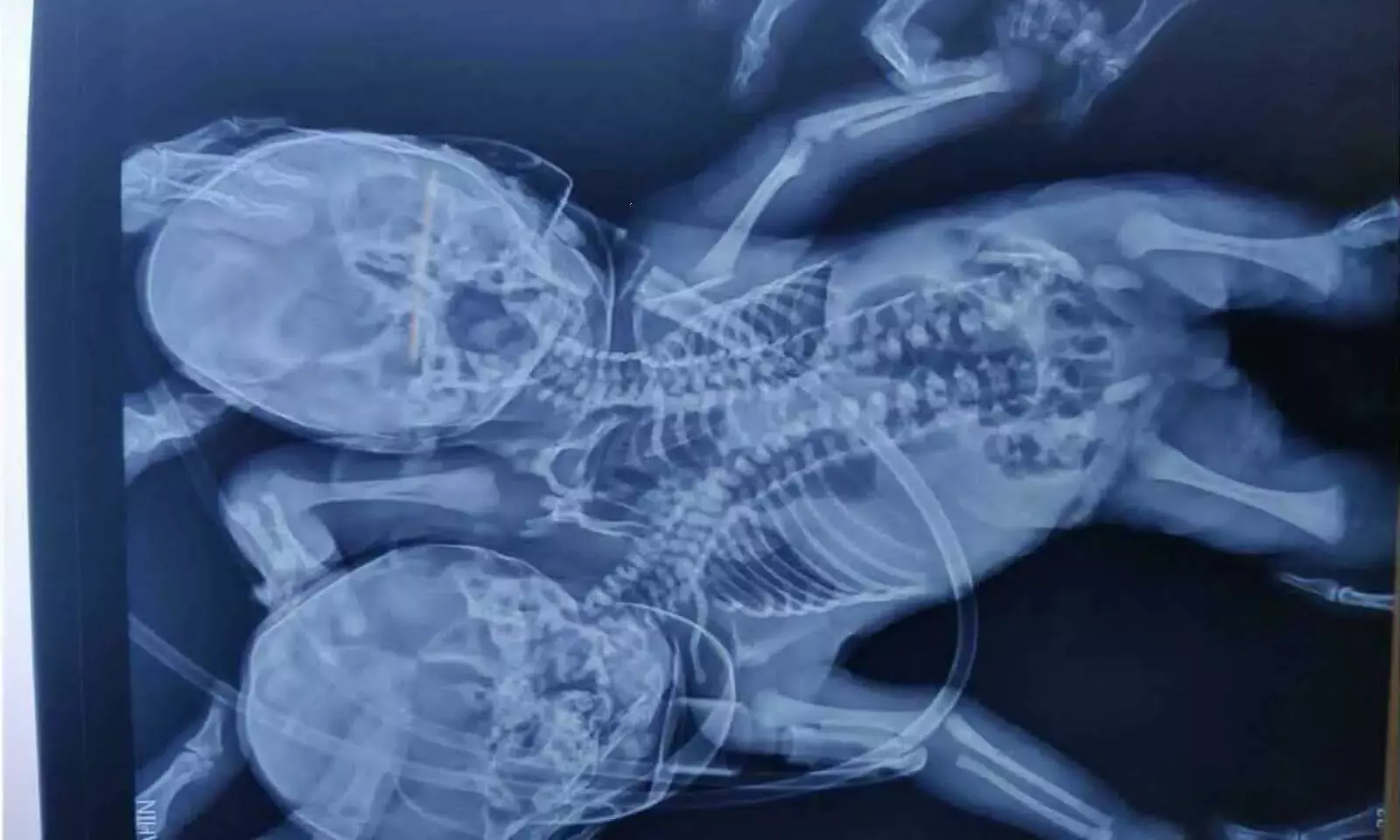Explained: The Rare Condition Twins Born with One Torso Suffer From
In MP's Ratlam, a newborn suffers from Dicephalic Parapagus, a rare genetic disorder which happens due to the incomplete formation of twins from a single zygote

Photo: Dr Brajesh Lahoti/ Paediatric Surgeon/ Maharaja Yashwantrao Hospital, Indore
A woman gave birth to a baby with one torso, two heads, two hearts and three hands in Madhya Pradesh's Ratlam on March 30, 2022. The baby was later admitted at Maharaja Yashwantrao Hospital in Indore for further treatment.
Parents of the newborn, who has one arm near a head, were not aware of the condition as during ultrasound sessions, the doctors had found that they would be having twins but were unaware of this condition.
Dr Brajesh Lahoti, paediatric surgeon treating the baby in Indore's Maharaja Yashwantrao Hospital, said the baby is in a critical stage. "The baby is critical and on oxygen but we have started giving him milk," Dr Lahoti told FactChecker. "It is very difficult to say if the child will survive because these cases see high mortality," he added.
This rare condition is called Dicephalic Parapagus or dicephalus (two-headed) parapagus (conjoined twins). 'Dicephalus' is a type of various subsets of parapagus.
"It was detected in the late second trimester but the sonography was conducted in a smaller centre so they could not confirm the type of the anomaly," he said.
What Causes Dicephalic Parapagus
Dicephalic Parapagus is a rare genetic condition caused by an incomplete separation of monozygotic twins occurring after the first two weeks of conception. This means that instead of fully separating to form two foetuses, the embryo partially separates resulting in both foetuses to be physically joined — often at the chest, abdomen or pelvis.
"This condition mainly happens due to the incomplete formation of twins from a single zygote," Dr Ravindra Ramadwar, consultant paediatric surgeon at PD Hinduja Hospital & MRC, Mumbai, told FactChecker. "When the sperm and ovum fuse, it forms a zygote and this grows into an embryo. It's an uncommon scenario and hence a rare anomaly," explained Dr Ramadwar.
True incidence of conjoined twins is approximately 1 in 2 lakh live births, globally. Of these, less than 0.5% of the cases are dicephalus parapagus twins. "In India, we do not have the record and since most cases are stillborn children we do not know the true incidence of this condition," he added.
According to a 2019 case report, there are two popular theories of development of conjoined twins: fission theory (incomplete fission of a single embryonic disc 13 to 15 days after the ovum is fertilised) and fusion theory (secondary fusion of two separate monovular embryonic discs leading to developmental anomaly). But the fusion theory has been dismissed and is no longer believed to be the basis of conjoined twinning.
Parapagus twins are fused in a ventrolateral manner (front and side) and hence lie side-by-side. While the twins are generally conjoined at the chest they have separate respiratory, gastrointestinal and genito-urinary tracts. Further, two spinal cords, two vertebral columns, two legs and more than two upper limbs are present. 87% of cases are the ventral (front) type while 13% are the dorsal (back) type.
Conjoined twins can be detected as early as 12 weeks of gestation on ultrasonography, according to a report by the European Society of Radiology. "Conjoined twinning should be kept in mind when monozygotic twins are encountered. Both twins in face-to-face position or in breach with polyhydramnios (excessive accumulation of amniotic fluid which surrounds the foetus in the uterus) should raise the suspicion of conjoined twinning," read the report.
Survival Rate
Mortality rate and stillbirths are high in dicephalus twins. The case study showed that 40% of conjoined twins are stillborn and 35% die in the first 24 hours of birth. Besides, only 60% of surgically treated conjoined twins survive. Spontaneous abortion rate in conjoined twins is as high as 60%.
Amongst those who are born, survival rate mostly depends on the shared anatomy of internal organs. According to Dr Ramadwar, in medium to long survival cases the quality of life affected of survivors and their caretakers is majorly affected.
Treatment
When asked about the complications posed to the mother of the foetus, Dr Ramadwar said, "The foetus can pose a risk to mothers because they can create anatomical problems – becoming parasitic and not growing, etc." Secondly, it is important to conduct a caesarean delivery (C-section). The delivery should be planned properly, he added.
While surgical correction is possible, it is highly complicated. Moreover, it is nearly impossible to conduct a surgery in a dicephalus parapagus twin due to the presence of two heads. In this case, only an early antenatal detection and choice of medical termination of pregnancy can be offered to the parents.
The paediatric surgeon, who has dealt with two such cases in the past, said most of these babies pose a risk to the other twin. "They have internal connections where one baby can act as a parasite while draining everything from the other baby," he said.
The team that decides on surgeries prefers to wait for the children to grow rather than perform surgeries as soon as they are born. Further, a thorough investigation is conducted of all associated anomalies, right from the central nervous system to the cardiac system, lungs, intestinal tract, spinal tract, urinary system, genitals, etc. These sections need to be fully evaluated.
After this, a multi-disciplinary committee decides on the planning of separation or the best way to deal with these babies. These children require immense support from the society, not only medical support but financial, psychological and social support, Dr Ramadwar said.
"I am aware of three to four sets of babies who have survived these surgeries. There are many cases of parents abandoning these babies in our country. So, it becomes the social responsibility of the hospital. I remember keeping these babies in the hospital for weeks to months," he concluded.


